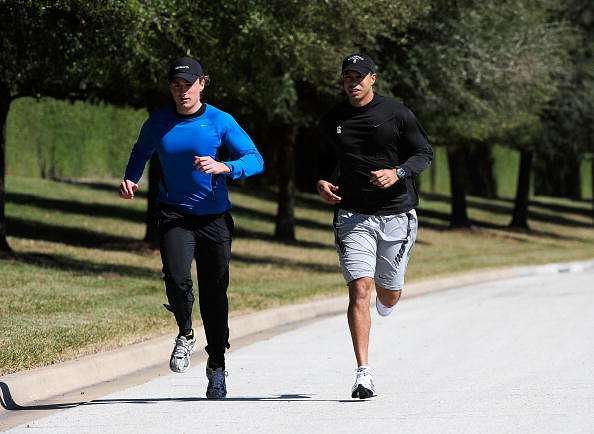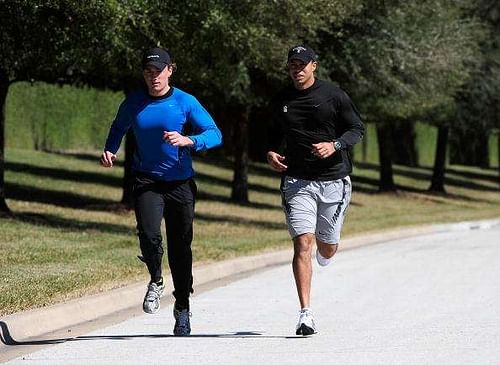
Fitness in Golf – a paradigm shift

To say that Tiger Woods has made enormous contributions to golf would be an understatement. His sustained dominance over several years amply proves his greatness as a golfer.
It remains to be seen whether he will ever regain that form or even come close to it. However, the effect of one of his most important contributions to the game can be seen in present times at any large-scale tournament across the globe.
I am talking about the fitness aspect in golf.
In an era where pot-bellied, un-fit golfers ruled the world-ranking charts, Tiger challenged that norm, and instilled the importance of being physically fit in a sport that is as demanding as any other. He was not just considered a golfer, but was one of the first few from the sport to be considered an all-round athlete. He devoted enormous focus and importance to a structured fitness regime; this saw him grow from a lanky college kid to a beefed-up muscular athlete in the span of a few years.
I am sure golfers such as Dustin Johnson, Rory McIlroy, Jason Day and Jordan Spieth, to name a few, are all golfers who idolised Tiger Woods while growing up, and got their sense of physical fitness from him.
Here’s Rory McIlroy’s (the man who took on the fitness mantle from Tiger Woods) outlook on the role of fitness in golf:
There is a common notion that a golfer does not necessarily require to be physically fit. I believe that that stems from the idea that walking (in golf) is not as demanding as running in other sports (say, soccer). But the notion couldn't be more wrong!
My introduction to being physically fit and healthy came at a young age. Being from a sporting family, a lot of importance was given to physical activity and the right diet, which continues till today. It is a way of life for all of us.
To give us a sense of why it is important for a golfer to be fit, I have decided to let an expert give his opinion on the matter. Deckline Leitao is a strength and conditioning specialist and I have been training with him for the last 6-7 years.
Here are his views on fitness in golf:
“The golfer’s power in the swing comes from a coordinated and explosive action taking place between the legs, core, shoulders, arms, wrist, golf club and ball. It can be compared to a powerful boxing hook punch that comes from the side of the body and is produced by the whole body rather than only the arms.
A powerful chain is only as strong as its weakest link. It is therefore important to remember that no area in the golfer’s body can afford to be weak because various joints, muscles and structures work together.
The power in a golf swing is produced repeatedly in the same direction by the body, and thus it is imperative that a golfer’s body is conditioned to constantly pull and recoil like a powerful spring that is strong yet stretchable. Therefore, a dedicated strength and conditioning (S&C) programme is a must for a competitive golfer, just like for any other sportsperson.
Even the easier looking putts require a great amount of stability, muscle endurance and control in the legs, lower back, shoulders and arms to create fine touches that could mean the difference between winning and losing.
But it is essential that a golfer’s S&C program is specific to their requirements; this can be achieved by working on the qualities of stability, strength and power especially in the transverse (rotational) plane. Therefore, it is important to choose exercises that improve golfing performance, rather than exercises that just look tough or cool but have little carry over effect to the sport.
Along with improved stability, strength and power development, the other important reason for a golf-specific S&C program is to prevent common over-use injuries in the knees, hips, lower back, shoulders, elbows and the wrist.
Due to the powerful rotation that the body goes through in a golf swing, there is tremendous load on the body, especially on the spine. Therefore, the role of a strong and stable core should never be underestimated in golf.
Any sportsperson needs to remember that the role of their strength training is to add value to their game. Many times, I have reminded over-enthusiastic sportspersons that no medals are won in the gym, and that simply performing unrelated tough exercises in the gym might look impressive but might not be effective for their sport.
Every single exercise or drill in their S&C training should have at least five clear reasons how it will help their sport. Right exercise is like right medicine; it might not look great but it cures you, and it becomes poison if abused!
Anisha started off as a very skinny and weak girl. And it is very pleasing to see her transformation into a toned-up, strong golfer known for her power. Also, the fact that that since she started a dedicated S&C programme in 2011, she hasn’t suffered any major injury reveals why it is important to train optimally.
I would say that it is the simplicity and consistency of her training approach that keeps her strong.
I cannot agree more with what Deckline has said. I look at fitness as an integral element to achieve success on the course, remaining injury-free, and attaining an overall healthy and fit lifestyle.
Also Read: All you wanted to know about golf but were afraid to ask!